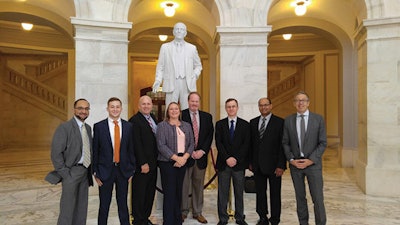
Whenever new regulations are delivered to the doorstep of an industry, it can cause understandable dismay. Sometimes, though, the shift in requirements can simply provide a boost in getting manufacturers where they’re already going. The new rules governing dedicated-purpose pool pumps fall into the latter category, according to many in the industry.
“It’s going to expand what has already been happening for a while now,” says Jeff Farlow, program manager of energy initiatives for Pentair Aquatic Systems.
First published in January of this year and officially finalized and promulgated on May 18, the new rules from the Department of Energy mandate that all dedicated-purpose pool pumps meet certain operational efficiency standards.
The regulations were shaped with extensive input from a working group comprised of industry representatives, energy-efficiency advocates and experts from electric utilities. These stakeholders were charged with establishing a reasonable efficiency standard for pool pumps with the particular intent of ensuring the affected devices were properly differentiated from industrial pumps. From the beginning of the process, there was a strong awareness that the rules needed to reflect the specific needs and interests of the pool and spa industry.
For instance, the DOE cannot base regulations on the end application such as inground vs. aboveground pools, but rather a technical or physical product difference. At the same time, it was recognized that inground pools with larger single speed pumps comprise the vast majority of the overall energy saving opportunities. As a result, the working group created multiple product definitions such as self-priming, which represents nearly all inground pool pumps, and non-self-priming, which applies to most aboveground pool pumps, so that separate requirements could be applied.
Self-priming pumps were further broken into two categories so that “small” pumps could have a less stringent requirement than larger models whose minimum allowable weighted energy score is effectively out of reach for single-speed pumps. The net result is that, based on current technology, most inground pumps sold in the market will be variable speed once the regulation goes into effect.
Smaller self-priming pool pumps, non-self-priming “aboveground” pumps and pressure cleaner booster pumps have increased efficiency targets but are expected to remain predominantly based on single-speed designs. The test procedure does not apply to integral cartridge filter pool pumps, integral sand filter pool pumps, storable electric spa pumps or rigid electric spa pumps.
According to information published by the DOE in the federal register, more than 95 percent of all dedicated-purpose pool pumps are utilized by residential, single-family swimming pools. Only a tiny fraction of the dedicated-purpose pumps in use are found in commercial and community pool use.
By some estimates, the new standard will lessen the overall energy draw of pool pumps by approximately 70 percent. Considering the typical pool pump that operates outside of the pending requirements can pull up to 6,000 kWh per year — or the rough equivalent of half the yearly draw of the average U.S. household — it’s not a small shift. Multiply that by the 5 million inground pools and 3 million aboveground pools that could be affected, and it becomes abundantly clear that the reduction in national energy consumption footprint will be enormous. That’s good for the overtaxed energy grids, consumers made woozy by their monthly electric bills and the environment.
In their rigorous analysis of the new pool pump rules, the DOE considered the overall benefit to consumers and the likely positive environmental impact, determining that the value of implementing the new standards outweighed any challenges that might arise from this industry shift. The agency asserts the new standards should be viewed as “the maximum improvement in energy efficiency that is technologically feasible and economically justified,” adding that the standards will “result in significant conservation of energy.”
In addition to the efficiency standards, the new rule requires that integral cartridge-filter pool pumps and integral sand-filter pool pumps are equipped with a timer. The working group recommended against revised standards for either waterfall pumps or pool filter pumps running at 2.5 hydraulic horsepower (approximately 5.0 motor horsepower) and above. The DOE definition of a waterfall pump is a pool filter pump with maximum head less than or equal to 30 feet, and a maximum speed less than or equal to 1,800 rpm.
The federal regulatory move privileging one type of pump over another isn’t forcing some novel invention onto the marketplace. Variable speed pool pumps have been available for over a decade. In fact, in many areas where pools are most prevalent, state regulations already make variable speed pumps the norm.
The shift got underway with the establishment of California’s Title 20 energy law, which went into effect in 2008. Other states — notably Florida and Arizona — followed suit. APSP further attempted to bring the industry together on a more even footing with its APSP-15 consensus standard. The new DOE regulations complete the evolutionary process.
Although variable speed pumps have already seen increasing prevalence in the marketplace — both in and out of states with regulations that favor the more efficient equipment — this doesn’t mean the industry is entirely prepared for the seismic shift set to take place.
“In general, this is going to be a significant change to the industry,” says Scott Petty, global product manager for pumps and filters at Hayward Pool Products. “Even though there are regulations related to pool pumps in certain areas of the country, this is a federal requirement, and manufacturers will not be able to sell into the marketplace products that are not compliant.”
RELATED: The Unintended Side-Effect of Arizona's Title 44 — A Robust Refurbished Pump Market
Even in those states that already have more stringent efficiencies for pumps on the books, the reach of online commerce has meant there is always the opportunity for non-compliant product to enter the market. Since state agencies aren’t able to devote a lot of personnel hours to prowling neighborhoods for pumps out of compliance, the skirting of those regulations largely went uncited.
But consumers can’t install non-compliant pumps if they’re not available in the national marketplace. These new rules will clear them off shelves entirely, even if it will take some time before manufacturers have to make sure their entire line meets the new standard. The date for full compliance arrives in July 2021. There are a lot of calendar pages between now and then, but Petty says it will arrive sooner than everyone thinks.
“The regulation is four years away, which may seem like a long time, but it won’t be,” Petty stresses. “And beyond what manufacturers are going to need to do to be prepared for that, I think the industry — and it truly is the industry: manufacturers, distributors, dealers — has to start now in planning education and communication efforts.”
The need for an education strategy acknowledges that limiting pool pump options to variable speed might be a tough sell for consumers. The reason is simple: On the front end, variable speed pumps are noticeably more expensive.
The key to helping consumers transition to more efficient pumps, according to Farlow, is helping pool owners and others peer past that initial price tag.
“One of the biggest reasons for federal minimum efficiency regulations is because consumers and even contractors focus exclusively on the first cost or the purchase price of a product without taking into account the cost of ownership, which includes the electrical operating costs for the life of the product,” notes Farlow, who served on the working group that hammered out the policy. “If the majority of people took into consideration the cost of ownership in their purchasing decision, then there would be minimal need for these federal regulations.”
Speculation about how more forward-thinking approaches to pool installs could have made variable speed pool pumps predominant without government intervention might strike some as fanciful, but the math backs up that theory. When it comes to the operational costs of variable speed pumps, analysts peg the savings at an average of $2,000 over the life of the equipment. Nationwide, consumers will likely see a collective energy cost reduction of $13 to 28 billion.
Getting those long-term cost savings into the discussion can transform perceptions, making the change into a clear net positive rather than some unwanted nuisance limiting choice. The situation is akin to the establishment of Energy Star labeling. There were those who groused about government intrusion when the DOE and the EPA established the Energy Star program 25 years ago, but it’s now rare to find an appliance buyer who doesn’t scrutinize the label before making a purchase, hunting for the model that will take the biggest slice out of their monthly bill.
Since there are dealers and distributors who’ve already been driving the market for variable speed pumps, a template for changing the conversation is out there.
“I think we’ve reached a point where all of our industry’s early adopters have embraced that technology and they’ve worked that message into their sales technique — their sales pitch — and into their product offerings that they make to consumers,” Farlow says. “A big chunk have already accomplished that.”
Although the energy savings are the prime driver for the new regulations, there are other benefits to variable speed pumps that can be highlighted to consumers. They run quieter, typically offer better filtration and sanitization through longer run times at lower speeds and their efficient operation means less stress on the equipment leading to a longer lifespan. All of these attributes are likely to be celebrated by end users.
“It really is better,” Petty says. “You just have to overcome that initial sticker shock.”
Even if the industry can get consumers fully comfortable with the idea of being limited to variable speed pumps when installing a new pool, there’s another slight drag on universal use of the devices.
The new DOE rules apply to complete pump installs, but have a blind spot when it comes to the familiar scenario when only a motor needs replacing. If a pool owner can repair a malfunctioning pump with a new motor, the replacement motor doesn’t have to comply with the DOE rules. That could delay the fundamental goal of improved energy efficiency that the regulations aim to achieve.
A replacement part is obviously always going to be less expensive that a completely new unit. If that replacement part is also held to lesser standard than fresh-off-the-line equipment, the cost differential is going to be even more lopsided.
“People are often in the market for a new pump when their motor fails,” Petty says. “Today, people have a choice of replacing the pump or replacing the motor. That choice is still going to exist in the future. And in the future, if pumps are regulated and motors are not, there’s going to be a significant price disparity. And we believe it would have not only a significant detrimental impact to manufacturers of pumps, but ultimately undermine the whole reason for this regulation, which is to save energy.”
Petty further cautions that attempts to mend pumps with replacement parts might not only forestall the movement towards widespread energy efficiency, but may actually make the equipment even more problematic.
“If anything, the pump may not be as efficient as it was if the replacement motor is not the same as the original,” he says.
The absence of language relating to replacement motors isn’t an oversight. The strictures around crafting the new rules prohibited tackling efficiency standards for both pumps and replacement motors at the same time. The working group and other observers identified the chink in the rule’s armor, but had no means to address it.
During the public comment period between the rule publishing in January and becoming permanent in May, plenty of people weighed in on the lack of corresponding regulations on replacement pump motors. A clear consensus emerged.
“Many of the stakeholders that provided feedback during the comment period made it very clear that this was a good rule in general, but in the absence of closing this loophole, the savings would never be achieved,” Farlow says.
RELATED: To Sell Variable Speed, Show Your Customers the Savings
In response, nearly everyone involved insists that attention will now turn to similar rules around replacement motors. The hope and expectation is that the relevant discussions can be fast-tracked, allowing for corresponding rules for pumps and motors to go into effect at the same time.
While several of the conservation efforts initiated while Barack Obama was in the White House are being disassembled by the Trump administration, that’s not likely to be the case with the move to rules that necessitate variable-speed pumps. Although the rule was published a mere two days before the most recent presidential inauguration, it was the current DOE staff that conducted the final evaluation of the new standards and made them the law of the land this May.
Overall, the complaints have been minimal. Most see this as a move that will ultimately be beneficial for everyone.
“I see it as a good opportunity for our industry,” Farlow says. “I see it as our industry contributing to energy savings on a national level. I see it as a good thing for consumers who will now have very energy efficient options, exclusively.”
































![IPSSA’s incoming President Michael Denham [left], Rose Smoot, IPSSA Executive Director [center] and the outgoing President, Todd Starner [right].](https://img.aquamagazine.com/files/base/abmedia/all/image/2024/04/New_IncomingPres_MikeDenham_RoseSmoot_outgoing_president_ToddStarner_IMG_3920_copy.662682e0cbd3a.png?auto=format%2Ccompress&fit=crop&h=112&q=70&rect=0%2C345%2C3024%2C1701&w=112)




